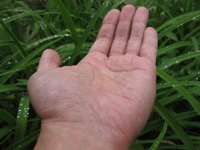Many faces of the bolero "Dos Gardenias"
I encountered an intriguing article “Brazil’s Maria Rita Rediscovers Her Mother Through Music”.
Maria Rita
The name “Maria Rita” was familiar to me for only one reason: exactly one year ago, by coincidence, right after attending a music performance, I was looking up performances of the bolero “Dos Gardenias” on YouTube, in order to see what was out there, and also to find a “karaoke” version I could use to practice singing to and playing the flute to (I ended up playing the piece on flute a month later at a party), and one of the performances that struck me as notable and unusual was hers.
It turns out that in this NPR program, when asked to choose a musical selection to end the program with, Maria Rita chose her recording of “Dos Gardenias”. You can watch a video of a live performance of hers here (sorry, the provider did not allow it to be embeddable). Do watch it: I found it strangely mesmerizing. It is understated compared to “normal” bolero style, yet expressive in its own way. Also, this video has her moving to the music while singing, eyes closed.
Anyway, it turns out that Maria Rita’s mother was the famous Brazilian singer Elis Regina, who died at 36. The interview was interesting because it brought up the issue of what it’s like being the child of a famous musician, because if you’re a musician also, then there are always comparisons and questions.
But what I want to return to my real topic, which is the bolero “Dos Gardenias”, one of my favorite boleros ever.
Love on first listen: Ibrahim Ferrer, 1999
I first encountered “Dos Gardenias” through Ibrahim Ferrer’s performance in Buena Vista Social Club, the film and the CD, which I came across in 2000, shortly after it came out.
I still love this live performance by Ibrahim Ferrer:
Here he is from the CD:
Why I love this song
The lyrics are singable and comprehensible.
The harmonic structure is distinctive, because it uses both the natural minor and the altered harmonic minor (raised 7th). This gives the song both an exotic and unstable feeling, corresponding to the emotional content of the lyrics. Check out when the 7th is raised and when it is not. In addition, the 4th is augmented. All this chromaticism drives well the song’s emotional content, implying various different modal regions coinciding with changes in the narrative.
The melody has a good dramatic range, and has varying intervals in motion.
Antonio Machin, 1947
I’m always interested in alternate performances of songs, both new and old. So I went back to the source, the great Antonio Machin:
This is faster than Ferrer’s rendition. If you examine the history of bolero performance in general, you will find that things have gotten slower and more sentimental over the years.
I find that there are pluses and minuses to different styles and speeds. I rather like the clarity and drama of the older faster tempo and style, but also like the room for more emotional expressiveness and freedom when slower.
Omara Portuondo, 2010
It turns out that Abby and I went to a concert by Omara Portuondo here in Pittsburgh on November 7, 2010, in which she performed “Dos Gardenias”. And someone captured that:
This was an interesting, very free rendition, without the usual full rhythmic backup, but instead featuring some subtle guitar accompaniment. It was different, but I did not like it so much. I think the regular structure of the song, the way the lyrics fit into the movement, makes it work better when the original motoric bolero rhythm is maintained, with the harmonic motion driving the narrative.
Lucrecia, 1996
Here’s a random other performance I found. I didn’t like it at all. The phrasing seems all weird and distorted, and the song’s been reharmonized strangely also.
Sertab Erener, 2007
I liked the performance of this Turkish pop singer Sertab Erener. She includes some distinctive middle Eastern styling that are unusual for this Cuban music, but her musicality cannot be denied. (Unfortunately, the “dance” sequences in this video are not at all bolero. Ignore the video.)
Conclusion
What can I say, I’m obsessed with this beautiful bolero. However you like this song interpreted, it’s a must-listen.
I haven’t sung it outside my home yet, but I guess I should get around to it, maybe at a party in the near future.
Postscript on Elis Regina
Check out Maria Rita’s mother, Elis Regina, singing the famous bossa nova song “Triste” in 1976:
